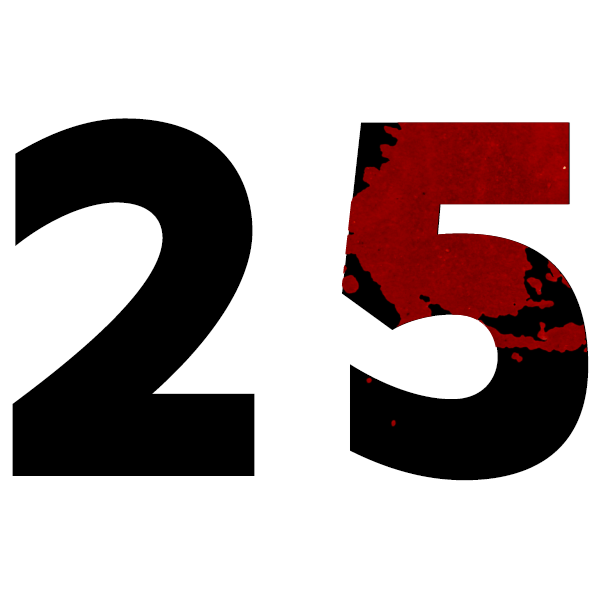
Ludum Dare 25
- [Lost content: Playable build (Web)]
- [Lost content: Source + Windows/OSX/Linux builds COMPLETE PACKAGE (60MB)]
- Compo 25 ended on December 17, 2012
PLAY-THROUGH WITH COMMENTARY
POST-MORTEM
What Went Right
1. Years of Preparation
I’ve been at this for more than two years now. The only jam I participate in is the Ludum Dare 48 Compo, because I love its brutal nature and it’s perfectly suited to my modus operandi. This was my 7th entry, and I’ve submitted working games for each. In the interim I’ve done more than a dozen Darkade jams, a handful of major projects, and all the while gathered skills with the tools I use. All of that culminates in these compos, which I see as tests of my abilities. So yeah, I’ve got experience and it really showed this time out. I managed to make what was in my head a reality, and within the time limit. It’s not without its warts and bruises, but it’s by far my best entry yet, and that’s all to do with the talent I’ve been cultivating through relentless full-time practice in the art of making videogames.
2. Focusing on Content
In the past I spent way too much time trying to come up with “innovative” systems to support my designs. This time I kept it simple so that I could spend less time mucking around in the guts of Unity and more time doing things like creating interactive objects. I chose a fixed camera, no lighting systems, and a very basic graphics pipeline. All of that enabled me to come up with a nice, tight little adventure game.
3. Holistic Asset Creation
For the first time in my history of attempting these challenges, I managed to correct something that previous post-mortems had identified: the uneven creation of game objects. In the past I would approach everything in a sort of layered way; code the interaction systems, block out the levels, add models, materials, textures, and finally audio. This time I made things as I went, treating each little asset as final, and imagining that I wouldn’t be coming back to polish it later. Whether or not this is a “best practice” is debatable; I’ll let my results speak for themselves. But by crafting every in-game object to be fully functional on implementation, I was able to keep cranking out content right to the end without worrying if I’d added appropriate SFX to a door, or properly textured a wall, or written a description for an area.
4. Fixed Camera, No (Visible) Characters
I decided almost immediately that the environment was going to be the main protagonaist, so I focused a lot of the storytelling production there. Like, how could I make this area interesting? How could I show a bit of history with this object? It wasn’t an extremely detailed execution, but that was only because I knew I only had 32 hours to work (I like to get 16 for sleep) and I could only communicate so much with that amount of production time. There were no (visible) humanoid characters, so there was no rigging or complex modeling to worry about. Also by fixing the camera and forcing the player to move in a grid-like fashion I could tightly control what they saw at all times. It also freed me from worrying about things like collision and physics. So yeah, for those who are complaining about the fixed camera/movement system, that was by design and it helped me execute the game on time. If I had allowed more freedom who knows how many more hours of production I would have needed to finish. More than 32, that’s for certain.
5. Sought Early Feedback
I threw up the production build almost immediately, I think within the first 4 hours, and right away I got a lot of good responses. It was clear that my initial camera choice (free, mouselook 1:1) was not comfortable. Certain things didn’t read well. Parts of the UI were confusing. I managed to address all of these concerns (some perhaps not to 100% satisfaction, it’s hard to work for perfection when you’re under the gun) but at least they were informed design choices. I knew by the time I submitted my entry that it had been tested to some small degree, and in game development even having one extra pair of eyes other than your own on the project can mean the difference between a good game and a bad one.
What Went Wrong
1. Not Enough Time Spent Mastering Texturing
I’ve identified a bit of a weakness in my speed pipeline, and that’s with texturing. Originally I envisioned using the “AO bake style” that you see in the game to complement some nice bumped/specular textures made either in Quixel’s nDo/dDo or Allegorithmic’s Substance Designer. As I worked I kept notes on what was to go where: grated floor panels in the main corridor, control panels on the machine and keypads, grime on the sewer walls, an so on. Right up to the last few minutes I had everything clearly mapped in my mind, but there just wasn’t time. I made that decision early on when going with the “holistic asset creation” method mentioned above, and I told myself that the AO bakes would be acceptable. And I think they are, I mean at least the game has a unified look to it. But it certainly wouldn’t hurt to have a few detailed textures in there, either.
2. No Title Card
This shouldn’t bug me, but it does. The game jumps right from the standard Dark Acre splash into the game. I would have rather had a little title marquee with THE CONDEMNED animated somewhere on it, but whatever. It’s a vanity thing.
3. Looked At #LD48 & the Ludum Dare Site During Compo
I think somewhere I’m quoted as saying that one of my secrets of success is how little I engage with Twitter/blogs/comments. And I think this is still the truth, but for this compo I let that discipline slip a bit. I figured making a few community posts on the site would help. Sadly, the pessimist in me tends to focus on the negative, so when confronted with people complaining about the theme, or dropping out, I got a bit down. But then I said to myself, “screw those weak bitches” and let their failure fuel my success. There’s only ever been one theme for LD48 for me, and that’s “make a playable videogame in 48 hours or less, and make it one that doesn’t waste anyone’s time”. I’ve managed to do this 7 times in a row now. The streak is real. Now if only I could win the thing I could retire.
LIVE UPDATES
0:00:11 Good theme, not that it mattered. The theme is always “make a game in 48 hours or less”. Putting together a design document.
0:00:42 Enough of a skeleton of an idea to know what systems I’ll need. Starting work on the basic interaction stuff.
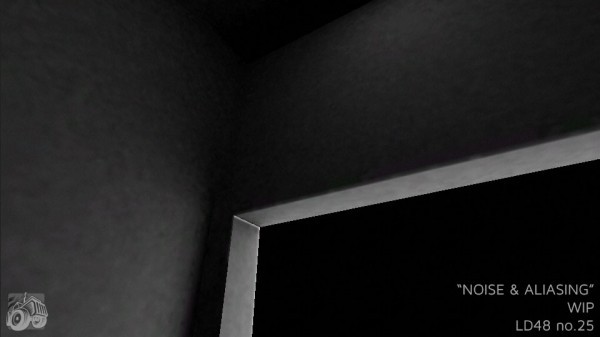
0:02:00 Seems the rendering pipeline is as I left it, ages & ages ago, when I did that one video for The Child with the ball wandering the hallways.

0:03:46 Calling it a night here on the West Coast; still maintaining decent sleeping hours. I figure it’s important. That I’m not 20 anymore, this shit takes a lot out of me. Got most of the first area rendered & the movement/camera code seems to be working OK.
0:12:11 Awake after a solid 8 hours of sleep. Had a few ideas before sleeping, managed to put them into the design doc. Now to see if I can implement
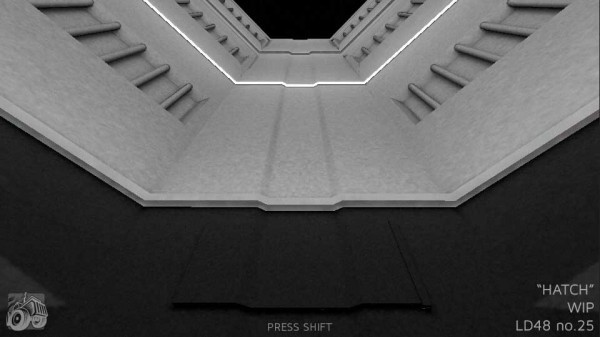
0:14:53 Expanding the opening area & testing movement code. Everything going according to plan.
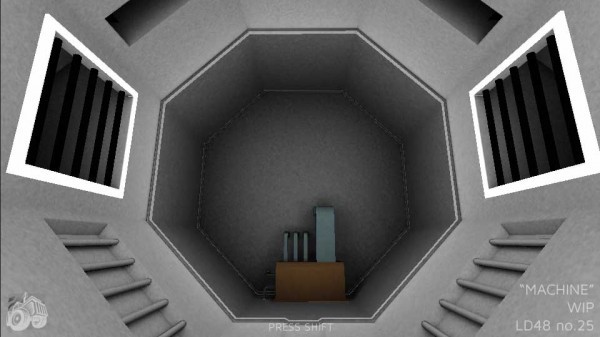
0:17:46 Lunch time. Capped off the first corridor, will test inventory & interaction next.
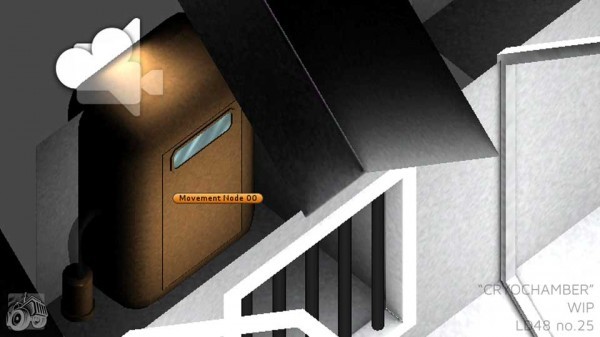
0:20:33 Waited a bit on testing interaction, wanted to make sure intro mechanism worked fine. There’s now a “cinematic” beginning to the game, but it’s only 10 seconds long. Movie-making for the impatient.
0:23:50 Crawling up on one day. Have a solid idea oh where to take the plot, some optional rooms worked out. Starting to feel like this a reasonable pace for the quality I’m getting. I just hope none of my systems are crossing their wires, but that’s the stuff that comes out once you can put it into wider testing.
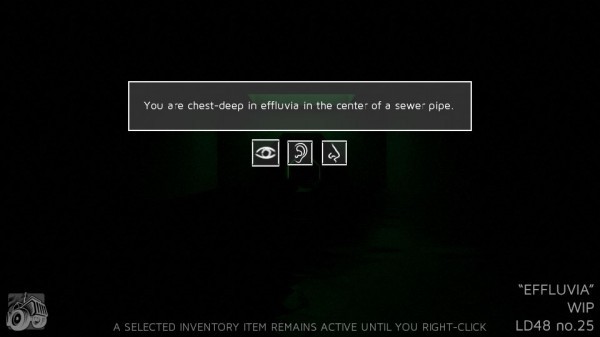
1:04:49 Time to call it a day. If I can get the two more areas that currently live in my head into the game it’ll be done and I’ll be able to rest easy. So far this has been the best LD to date, and seeing as I’ve done the last 7 in a row that’s saying something.
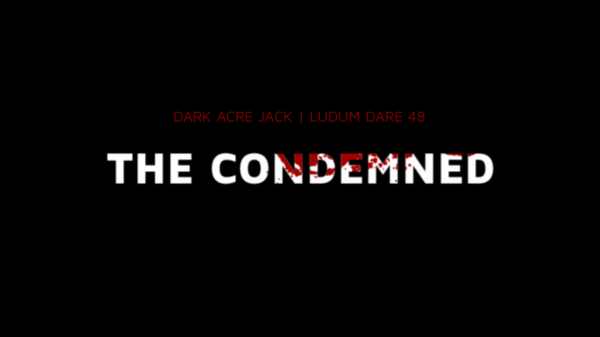
1:13:11 Morning. Just under 11 hours left. Should be plenty if I can shit this stuff out of my head in a timely manner. Same as when I went to bed: two key areas and a cutscene and we’re golden. Oh, and I just thought of a title.
1:23:45 Submitted. I feel good. Playthrough video and post-mortem to come.
SCREENSHOTS
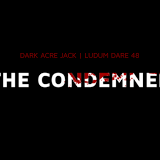
PROJECT STATUS
- Jack’s declaration of intent (An embarrassing and astonishing look into how flip I was. –Ed.)
- Completed
- 99th Overall, 13th Mood, 28th Audio, 91st Graphics (902 in the field)
- Official theme: You Are the Villain
- Refer to the Ludum Dare website for full rules and details
2012.12.14 – 2012.12.17